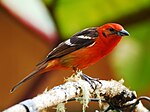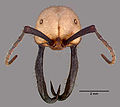Eciton burchellii is a species of New World army ant in the genus Eciton. This species performs expansive, organized swarm raids that give it the informal...
33 KB (4,192 words) - 01:35, 10 September 2024
species is Eciton burchellii, which is also more commonly known as the army ant and is considered the type species. Eciton burchellii and Eciton hamatum are...
7 KB (768 words) - 04:09, 26 August 2024
Labidus, and Eciton. The largest genus is Neivamyrmex, which contains more than 120 species; the most predominant species is Eciton burchellii; its common...
40 KB (4,585 words) - 14:46, 6 November 2024
from Mexico to central Brazil and Bolivia. The species differs from Eciton burchellii, in that it does not fan out into the underbrush when foraging. Rather...
2 KB (165 words) - 11:26, 29 October 2022
encountered during the day. It is closely related to the Eciton burchellii species.[citation needed] "Eciton mexicanum". Integrated Taxonomic Information System...
2 KB (119 words) - 16:37, 28 July 2023
species most commonly attended by birds is the Neotropical species Eciton burchellii, which is both diurnal and surface-raiding. It was once thought that...
4 KB (514 words) - 02:01, 31 October 2024
by migratory driver ant and army ant colonies, such as the species Eciton burchellii. A nest is constructed out of the living ant workers' own bodies to...
2 KB (262 words) - 23:09, 27 December 2023
include other ants. It is closely related to the Eciton burchellii species.[citation needed] "Eciton vagans". Integrated Taxonomic Information System...
2 KB (112 words) - 07:46, 22 April 2022
to undertake more efficient collective exploration. The army ant Eciton burchellii provides an example of using pheromones to mark and maintain foraging...
54 KB (6,260 words) - 08:53, 8 November 2024
first sign of threats. The army ants of South America, such as the Eciton burchellii species, and the driver ants of Africa do not build permanent nests...
155 KB (17,320 words) - 22:45, 12 November 2024
species most commonly attended by birds is the Neotropical species Eciton burchellii, which is both diurnal and surface-raiding. It was once thought that...
46 KB (5,304 words) - 18:40, 15 May 2024
beneficial symbionts. Mites also parasitize some ant species, such as Eciton burchellii. Most larvae of Parasitengona are ectoparasites of arthropods, while...
47 KB (4,996 words) - 10:24, 5 September 2024
within ant nests, some beetles even marching with the aggressive Eciton burchellii army ants. The Jesuit priest Erich Wasmann, who discovered ant mimicry...
30 KB (2,845 words) - 01:47, 31 October 2024
glean fruit. It has been reported ambushing swarms of army ants (Eciton burchellii) carrying wasp larvae and pupae, and eating both ant and wasp. The...
12 KB (1,394 words) - 17:49, 1 May 2024
Burchell's coucal, Burchell's sandgrouse, Burchell's courser, and the Eciton burchellii army ant. A species of African lizard, Pedioplanis burchelli, is named...
9 KB (1,008 words) - 12:57, 14 November 2024
exclusively other ants, while other ants like the infamous swarm-raiding Eciton burchellii eat more or less all arthropods in their paths, including any ants...
14 KB (1,517 words) - 20:10, 26 October 2024
devastating predators of P. erythrocephalus are army ants such as Eciton burchellii. These ants attack wasp nests and consume the larva and pupa, often...
22 KB (2,752 words) - 19:11, 8 December 2023
in 5 genera. Tribe Cheliomyrmecini Cheliomyrmex - 4 spp. Tribe Ecitonini Eciton - 10 spp. Labidus - 10 spp. Neivamyrmex - 130 spp. Nomamyrmex - 2 spp. Bolton...
2 KB (191 words) - 11:06, 4 February 2023
Eciton burchellii army ants were used by the Mayans as living sutures, their powerful jaws holding a wound closed....
83 KB (8,370 words) - 02:42, 8 October 2024
wife, Rettenmeyer identified 557 species of animals associated with Eciton burchellii, the greatest number of animals known to associate with any single...
14 KB (1,621 words) - 21:18, 15 September 2024
Tetradonia Tetradonia beetle attacking an adult Eciton burchellii worker ant during a colony emigration Scientific classification Domain: Eukaryota Kingdom:...
3 KB (223 words) - 17:17, 27 July 2024
on arthropods that flee foraging army ant swarms such as those of Eciton burchellii. It typically forages in pairs or family groups, perching within about...
12 KB (1,308 words) - 14:49, 30 May 2024




















